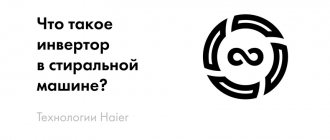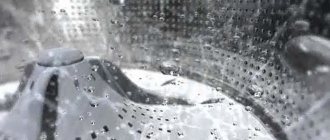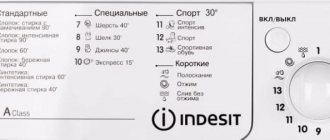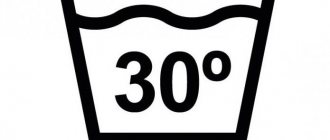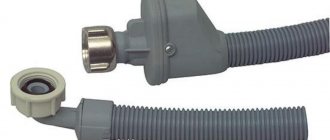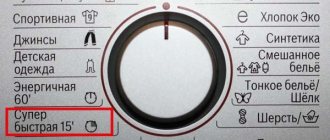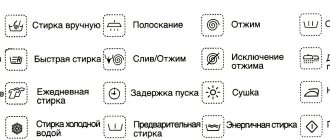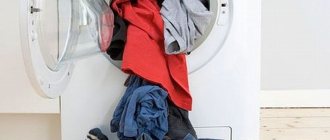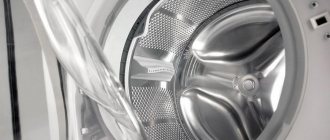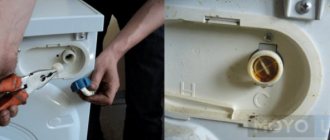26 Aug 2021
7499
Inverter motors, compared to brush-commutator motors, are quieter, last many times longer and consume less electricity. They come in two types: belt driven and direct driven, that is, they are attached directly to the drum of the washing machine. The warranty for the first type of inverters from Haier is 12 years, for the second type it is unlimited.
- Motor in a washing machine
- Pros and cons of an inverter motor
- Types of inverter motors
- Comparison of an inverter with a conventional motor
- How to care for your inverter
- Myths about inverter motors
- What is important when choosing a washing machine
Motor in a washing machine
The washing machine, regardless of the type of loading (frontal or horizontal), works on the same principle: the drum, together with the clothes, rotates in a layer of water and foam from the washing powder. Depending on the program, the drum rotates at different speeds (both in one direction and the other, periodically changing direction) and reaches maximum speed during spinning. The difference in how the drum is driven, how accurately it changes speed and how many revolutions per minute it can reach is made by the engine.
There are many types of electric motors: single-phase, three-phase, synchronous, asynchronous, with mechanical and electronic commutation, direct and alternating current and others. It is enough to remember that each of them has two key components: the stator (stationary part) and the rotor (rotating part). In washing machines (and household appliances in general), three types of motors are usually used:
- Collector (or brush, because special brushes - carbon contacts - are responsible for the electrical connection of the stator and rotor elements).
- Asynchronous (brushless, the rotor rotation speed does not coincide with the rotation frequency of the magnetic field created by the stator - it is either less at the time of acceleration, or more during the period of active operation).
- Inverter (also brushless, similar in principle to asynchronous, but the rotor is driven not by a magnetized armature, but by an inverter - a voltage converter).
In simple words, the inverter allows you to change the alternating current voltage from a 220 volt outlet to a range from 0 to 120 volts, and this is direct current.
Due to this, the inverter motor works more efficiently. The principle of operation of the inverter motor in a washing machine can be shown schematically. The picture shows that the inverter provides a smooth consumption of electricity, while other types of motors consume it spasmodically and inefficiently - they supply more voltage to raise the speed of the machine, reduce it when the speed of rotation of the drum needs to be reduced.
Comparison of the operation of two motors: conventional and inverter
Example: you have loaded 2 kg of laundry into the drum with a nominal capacity of 6 kg. If you have a brushed or induction motor, it will work at maximum power to spin the drum (as if there were 6 kg in it). The inverter will ensure more efficient operation of the engine without compromising the quality of the wash: it will supply as much voltage as is needed to spin the drum, taking into account 2, not 6, kg of clothes. The device will consume less electricity.
Do you need high revs?
We have already noted that inverter washing machines can operate at high spin speeds. As a rule, they are adjusted programmatically or manually. This is necessary because high speeds are contraindicated for some things. For example, in the Wool program they usually do not exceed 800 rpm.
When choosing a washing machine in relation to speed, you can proceed from the principle “more is not less.” You can spin cotton items at maximum, taking them out almost dry, and for more delicate items, reduce the speed to the recommended value.
The typical maximum for modern washing machines is 1400 rpm. For example, this Bosch WAT286H2OE .
Pros and cons of an inverter motor
- Runs quieter. This system has no brushes (the main cause of commutator noise) and has a higher torque-to-weight ratio. Other motors must spend more energy to achieve the desired speed. The more energy they expend, the more noise and vibration they produce.
- Consumes less energy both when rotating the drum and when heating water. The inverter does not use full power when it is not necessary.
- It breaks less often, but if it does, repairs cost more. Inverter devices have fewer moving parts and components that can wear out due to friction. The design is simpler than that of collector and asynchronous ones (although the control system is more complex). This is usually reflected in the warranty statements. For example, the warranty for Haier washing machines (and washer-dryers) with an inverter is 12 years, for analogues without an inverter - usually 1-3 years.
- Washing machines with an inverter can be 5–7 thousand rubles more expensive, but not necessarily. Prices for models with and without an inverter are often the same (at a discount you can buy it even cheaper). The technology has existed for 16 years, during which time it has become more accessible and left the “know-how” category.
Is it worth buying?
Who will be interested in the innovative machine:
- those who want to save electricity;
- lovers of silence in the house.
Of course, only the presence of a special engine cannot influence the choice; it is important to evaluate other characteristics: set of programs, tank material, functionality, etc. If you are looking for a budget option, you should not overpay for know-how.
Types of inverter motors
They come in both direct motion (the engine is located on the drum shaft, without a belt) and with a belt drive (the motor is at the bottom of the machine, connected to a pulley on the tank with a belt).
The type of inverter depends more on the design features of the washing machine than on the characteristics of the engines - they differ slightly. The belt may make a little more noise during operation, show lower efficiency and wear out over time, but otherwise the difference is minimal.
Haier washing machines use both engine options, but while the inverter with a belt drive has a 12-year warranty, the Direct Motion motor has a lifetime warranty.
Types of inverters in washing machines
conclusions
Let's summarize:
- All inverter SMAs are silent due to the brushless motor design and the use of direct drive.
- The cost of washing machines with ID is slightly higher, but noiselessness is not their only advantage. Since such machines are produced by leading brands, they have many other advantages - high-quality assembly, stylish design, high washing and energy efficiency, an abundance of useful programs, etc.
- The ancestor of SMA with direct drive and ID is the Korean brand LG; today they are produced by the world's leading brands - Bosch, Electrolux, Siemens and others.
Sometimes it is useful to delve into the technical nuances when buying household appliances. Machines equipped with inverter motors outperform analogues with brushed motors in all respects. They are more reliable, more economical, quieter, more durable, they are a little more expensive - but the difference in cost is more than compensated by the advantages available.
Comparison of an inverter with a conventional motor
For clarity, let’s compare two Haier washing machines that are close in price: HW70-BP1439G with an inverter (belt) motor and HW60-1239 with a standard one. Let's write down the characteristics:
Comparison table of models with and without inverter
Firstly, washing machines with an inverter operating principle are not always more expensive than regular ones (they are often sold at a discount). Secondly, in terms of key indicators, the inverter has an advantage - it is 27% more efficient (we are talking only about specific models). Although there is a difference in noise level and speed, it is not critical.
Based on energy consumption, the inverter will save approximately 41 kWh per year, or about 243 rubles (for Moscow at 2022 tariffs). The data is valid based on 220 washes per year with a full load, the “Cotton” mode and a temperature of 60 °C.
Which control is better?
There are three types of washing machine control:
- mechanical,
- electronic.
- sensory.
With mechanical everything is clear - this is the simplest option with physical knobs and buttons. If we talk about modern inverter machines, you will not find this in them.
Electronic control implies the presence of a display and menu. There are buttons here too, but there are fewer of them, and they serve mainly for menu navigation.
Touch control is no different from electronic control, except for the type of buttons. Here they are (you'll never guess) touch sensitive, making the control panel easier to keep clean.
How to care for your inverter
Motors in washing machines do not require special care, such as water supply filters or powder containers, which need to be cleaned every 1-3 months. If the inverter motor is faulty, the machine will not start and an error code will appear on the display (for Haier machines this is code F7). You won’t be able to repair it yourself; you need to contact the after-sales service department of the store where you bought the equipment. Almost any damage is reversible.
From the general operating requirements for Haier washing machines:
- Do not overload the device (your hand should move freely over the laundry).
- Do not wash small or sharp objects that could damage the drum or fall into it.
- Avoid leaks and use only the original hose set.
- Regularly check that all connections (power supply, drainage and cold water supply hoses) remain tight, dry and waterproof.
Myths about inverter motors
Several myths have formed around inverters. Technology is sometimes credited with doing more than it actually can.
Myth 1. Inverter motors guarantee a good wash. If we compare them with three-phase asynchronous motors, which have been used in washing machines from Haier and other manufacturers since 2005, they also cope effectively with washing and reach no less speed. Collectors cannot stand comparison.
Myth 2. Washing machines with inverters have more washing modes. It depends on the electronics; the engine has almost no effect on this parameter.
Myth 3: Inverters cost more. This was the case before, now the run-up is minimal or non-existent. The price is also affected by additional features, the size of the washing machine, the popularity of the brand and other factors.
Myth 4. Washing machines with inverters are more durable. It’s not just the engine that can become unusable in a car. More often, the oil seal, bearings, shaft wedge, electronics and other components fail. Carbon brushes, which are often used as a counterbalance to the inverter, carry more risks, but they can also last 10–20 years without failure if they are made with high quality and are lapped to the commutator.
Myth 5. The higher the drum rotation speed, the better. Depends on the type of items you are washing. For example, delicate fabrics at 2000 rpm (that is, in the drying mode) may tear. But of course, the higher the speed, the drier the laundry will be when it comes out.
The operating principle of such washing machines
This type of washing machine operates by inverting the current. To put it simply, the voltage is pre-converted and only after that is supplied to the stator. As a result, the engine speed is adjusted with greater accuracy, which allows you to significantly expand the number of washing modes.
Inverter machines can spin at speeds above 1,200 rpm. Accordingly, after the end of the washing cycle, clothes and clothes practically do not need additional drying. Such indicators were achieved thanks to the brushless design.
The program is selected via electronic or mechanical control. In the latter case, the mode is indicated using buttons, which is considered a more durable and reliable solution.
Well, in the case of electronic control, to start the wash you only need to press one button and the device will do everything on its own.
What is important when choosing a washing machine
The inscription “inverter” in the specifications is not a guarantee of a good purchase. The machine may be inferior to analogues with a standard engine (for example, asynchronous). Much depends on how the manufacturer implemented the model: what technologies were used, what circuit, components, processor, how well it was assembled, and so on.
In many cases, an inverter reduces noise levels, more accurately regulates speed and allows you to save on electricity, but in the end the unit must do two things efficiently: wash and spin clothes. The question with what accuracy the drum rotates is not the main one.
We wrote in this article what to look for when buying a washing machine. Here we repeat the key points:
- Loading type: horizontal or vertical. It depends on the space in the apartment where you plan to place the washing machine. Vertical will save more space.
- The capacity of the drum, as well as the size and dimensions of the device. For a large family (parents + two children), models with a load capacity of 8 kg or more are suitable. Also keep in mind that manufacturers indicate the weight of dry and wet laundry separately.
- Energy efficiency class. It is better that it is A+ and higher - this will allow you to further save on electricity
- Additional functions. For example, in Haier machines these include automatic washing of glass and hatch cuffs (Smart Dual Spray), steam treatment of clothes (Steam+Fresh), ultraviolet (UV) water disinfection and auto-weighing (Auto Weighing).
- Design features. For example, a special shape of the inner surface of the drum (Pillow) for gentle washing of delicate items.
- Price. Pay attention to discounts and remember about installation and configuration - some sellers charge extra for it. Haier has it free for freestanding washing machines and dishwashers.
Model overview
Cost-effectiveness, noiselessness and high quality washing make inverter-type washing machines increasingly popular and in demand. Let's review several models to understand the functional features of such equipment.
The table below shows the main characteristics.
| Model | Dimensions (H x W x D), cm | Noise level washing/spin, dB | Energy consumption per cycle, kW | Number of washing modes | Loading, kg |
| Electrolux EWW 51685WD | 85*60*53 | 51/76 | 1,07 | 15 | 8 |
| LG F1096 ND3 | 85*60*44 | 54/67 | 1,02 | 13 | 6 |
| LG F1296ND3 | 85*60*46 | 57/74 | 1,02 | 13 | 6 |
| AEGL 576272 SL | 85*60*45 | 49/73 | 0,81 | 16 | 6,5 |
| Siemens WD 15H541 | 85*60*59 | 46/74 | 0,75 | 15 | 7 |
| Bosch WLT 24440 | 85*60*44 | 56/78 | 0,91 | 15 | 7 |
| Samsung WW65K52E69S | 85*60*45 | 54/73 | 0,84 | 12 | 6,5 |
The Electrolux EWW 51685WD washing machine belongs to the premium segment. The model is equipped with a clothes drying function, a delayed start timer (20 hours), a program for washing rugs and blankets, a hand wash for wool/silk and a steam treatment mode. The OptiSense sensor system built into the machine automatically determines the load volume, the degree of soiling of the laundry and sets the necessary washing parameters. The maximum spin speed in the unit is up to 1600 rpm, energy efficiency class A, water consumption per cycle is 63 liters.
LG F1096 ND3 is an affordable, narrow model with the ability to be built under a countertop. It has modes for washing delicate fabrics, baby clothes, sportswear and duvets. The machine is equipped with a child lock; spin speed up to 1000 rpm, energy efficiency class A++, water consumption per cycle – 56 liters.
LG F1296 ND3 is a narrow machine with the ability to be built under a countertop. Equipped with a delayed start timer (19 hours), a washing program for rugs and blankets, children's clothes and a “health care” mode for people with allergies (thorough rinsing of the powder). The machine has a child lock, spin speed up to 1200 rpm, energy efficiency class A+, water consumption per cycle - 56 liters.
AEG L 576272 SL – free-standing narrow model. Has a wash program for delicate fabrics, night mode, anti-crease function, jeans mode, super rinse, quick wash and stain removal program; spin speed up to 1200 rpm, energy efficiency class A+, water consumption per cycle – 52 liters.
Siemens WD 15H541 model belongs to the premium segment. The machine is equipped with a clothes drying function, a delayed start timer (24 hours), a steam treatment mode, a child lock, a self-cleaning condenser, and a stain removal program; spin speed up to 1500 rpm, energy efficiency class A+++, water consumption per cycle – 57 liters.
The Bosch WLT 24440 washing machine belongs to the middle price segment; it is an economical unit with an optimal set of functions. The model is equipped with a delayed start timer (24 hours), has washing programs for delicate fabrics, wool and silk, children's clothes, sportswear, duvets, jeans. The unit has a night mode and quick wash; spin speed up to 1200 rpm, energy efficiency class A+++, water consumption per cycle – 38 liters.
Samsung WW65K52E69S model from the affordable segment is equipped with a delayed start timer (24 hours), a steam mode and a drum cleaning system. The unit has a program for washing silk and wool, children's clothes and bed linen, a quick wash mode and an additional rinse; spin speed up to 1200 rpm, energy efficiency class A+++, water consumption per cycle – 39 liters.
Manufacturers provide at least 10 years of warranty on inverter motors
Before purchasing an inverter machine, we recommend that you additionally review customer reviews on various forums. They will provide an opportunity to evaluate the functionality of the device and study in more detail the shortcomings that any technology has.
